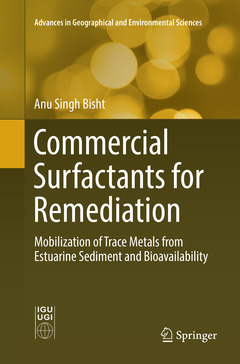Commercial Surfactants for Remediation, Softcover reprint of the original 1st ed. 2019 Mobilization of Trace Metals from Estuarine Sediment and Bioavailability Advances in Geographical and Environmental Sciences Series
Auteur : Bisht Anu Singh

This book demonstrates the benefits of using commercially available surfactants, or surface-active agents, for remediation of metal-contaminated soil and sediment. First the book offers theoretical reviews of commercially available surfactants, then it proceeds to a study of various available surfactants for the mobilization of metals. Surfactants representative of amphiphiles discovered in the digestive environment of sediment-ingesting organisms are used to examine the extent and rate of metal (Al, Fe, Cd, Cu, Mn, Ni, Pb, Sn, Zn) mobilization from contaminated estuarine sediment. Metals can cause harmful effects to the environment and organisms. It is difficult to treat contaminants that are often tightly bound to the extremely small size of the estuarine sediments.
The book also demonstrates the mechanisms of metal mobilization that appear to be related to complexation with monomers and adsorption to micelles of the anionic amphiphiles, and to the denudation of hydrophobic host phases or coatings on the sediment by micelles of both anionic and nonionic surfactants.
Readers obtain a better understanding of current commercial surfactants, their impact on the environment, and possible remediation. This transdisciplinary book contributes toward Sustainable Development Goals numbers 6 (Clean Water and Sanitation) and 13 (Climate Action) set by the United Nations and is useful for students and teachers of sediment studies, coastal studies, environmental sciences, hydrology, civil engineering, and policy sciences.
List of Abbreviations
List of Figures
List of Tables
List of Images
List of Appendices
Chapter-1 Introduction
Metals
Sediment
Sources of Sediment Contaminants
Sediment Contaminants
References
Chapter-2 Bioavailability of Metals in Sediment
References
Chapter-3 Solubilization of Metals in Invertebrate Guts
References
Chapter-4 Surfactants
Types of Surfactants
Properties of Surfactants
Surfactants as Remediating Agents
Mechanism of Metal Removal from Solids by Surfactants
References
Chapter-5 Commercial Surfactants for Remediation- Introduction
Sodium Dodecyl Sulfate (SDS)
Hexadecyltrimethylammonium
Triton X-100
Sodium Taurocholate
References
Chapter-6 Commercial Surfactants for Remediation- Methodology
Sampling
Sample Processing
Sample Digestion
Reagents and Working Surfactants
Experiments
Chapter-7 Metal Analysis
Inductively Coupled Plasma Mass Spectrometry (ICP-MS)
Inductively Coupled Plasma Optical Emission Spectroscopy (ICP-OES)
Metal Analysis
CHN Analysis
Data Presentation
Chapter-8 Metal Concentration
Sample Composition
Carbon, Nitrogen and Hydrogen
Chapter-9 Kinetics of Metal Release by Surfactants
Kinetics of Metal Release by HDTMA Surfactant
Kinetics of Metal Release by SDS Surfactant
Kinetics of Metal Release by Triton X 100 Surfactant
Kinetics of Metal Release by NaTC Surfactant
Kinetics of Metal Release by Synthesized Surfactant
Chapter-10 Surfactant Availability of Metals
Surfactant Availability of Metals by HDTMA
Surfactant Availability of Metals by SDS
Surfactant Availability of Metals by Triton X 100
Surfactant Availability of Metals by NaTC
Relationship Between the Metals Available by Different Surfactants
Comparison Between SDS and NaTC
Mechanisms of Metal Release by Surfactants
Comparison between the Metals Release by Proteinase K, BSA, NaTC and SDS
Relationship between the Metals Available by BSA, SDS AND NaTC
Chapter-11 Implication of Surfactants in Remediation
Implications for Metal Availability to Deposit-Feeders
Chapter-12 General Discussion and Conclusions
Chapter-13 Marine Conservation and Sustainable Development Goals
Appendices
Anu Singh Bisht is a dedicated and focused researcher with more than 7 years of extensive research experience in the areas of nanoscience, optics and microscopy, environmental science, and microbiology.
She has a Ph.D. in physics from the prestigious French institute École Normale Supériuere de Cachan. She completed her master’s in Erasmus Mundus Joint European Water and Coastal Management from Spain and the United Kingdom. She received a bachelor’s in microbiology from the University of Delhi, India. Most recently, she worked as a post-doctoral research fellow at the University of Technology of Troyes, France. She led research work on the development of new light-emitting hybrid nanosources for their application in telecommunication.
Anu Singh Bisht is a productive independent researcher with excellent credentials in designing research experiments; she operates specialized scientific equipment and conducts data collection, interpretation, result processing, and analysis. Her experience in scientific publication consists of more than 22 contributions to high impact factor journals and two book chapters. She has participated in several national and international conferences to present her research work and has also taken part in summer schools in France, where she presented her work. She received several awards and fellowships. These include a post-doctoral research fellowship from the Agence Nationale de la Recherche (ANR), France; a scholarship for her Ph.D. from the Centre National de la Recherche Scientifique (CNRS) Délégation Ile-de-France Est; an international scholarship for internship from the École Normale Supérieure (ENS) de Cachan; and an Erasmus Mundus Scholarship for a Joint European Master in Water and Coastal Management from the European Union.Describes different types of surfactants and their properties
Discusses surfactants as remediating agents
Provides experimentally proven surfactants for mobilization of metals from contaminated sediments
Points toward the implications of surfactants in remediation for sustaining coastal hydrology, environment and society
Date de parution : 02-2019
Ouvrage de 100 p.
15.5x23.5 cm
Disponible chez l'éditeur (délai d'approvisionnement : 15 jours).
Prix indicatif 116,04 €
Ajouter au panierDate de parution : 10-2018
Ouvrage de 100 p.
15.5x23.5 cm
Disponible chez l'éditeur (délai d'approvisionnement : 15 jours).
Prix indicatif 116,04 €
Ajouter au panier


